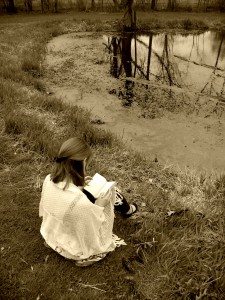 We’ve made it from the beginning pages, through the middle, and now we are reaching the LAST PAGES. These will NOT be the last pages from the Mavens, however. Read on:
We’ve made it from the beginning pages, through the middle, and now we are reaching the LAST PAGES. These will NOT be the last pages from the Mavens, however. Read on:
Cheryl Zach:
In one writing org I belong to, it’s said that the first page will sell the current book to your reader, the last page will sell your next. So what do you need on your last page? A satisfying ending, obviously. Have you truly wrapped up your problem? Did the main character, the protagonist, resolve the problem him or herself? Not a helpful adult–that’s fatal–not the best friend, not an act of fate, the ‘god from the machine.’ Are the emotional conflicts resolved as well as the physical? You may not want too neat a wrap up, it may not sound realistic, but you do want the reader to feel that the story is really resolved, or readers will never feel completely happy with the book. (Mind you, I have written at least one book with an ‘open’ ending (RUNAWAY) in that one important question was left unresolved because the two main characters couldn’t agree. Some books are just like that. You do what has to be done, or at least, what your characters demand. I hope in this case, the novel was still emotionally satisfying–the book did well, in any case, winning an award and selling well.)
Now, having admitted that every rule has an exception, what else can I say. If it’s a mystery, solve the mystery and don’t cheat and introduce the villain on the next to the last page. If it’s a fantasy or science fiction, stick to your own rules of logic. If you’re going to do something truly awful, like kill the protagonist, at least give some foreshadowing. That’s my rule, not everyone will agree. The late great Madeleine L’Engle, author of WRINKLE IN TIME and other award winning novels, said that writers for young people owed it to their readers to leave some hope at the end of their books. I agree. Not everyone does.
Last Pages: The ending is always important–you need to leave the reader satisfied. Has the protagonist resolved his/her problem/conflict, with only minimal help from others? Is it not too neat, so as to be unrealistic, but without too many loose ends? Have both the emotional/internal and external conflicts been dealt with? My daughter always says the ending needs a certain emotional punch, as well, that little extra something that may send you away smiling, or with a tear in your eye, but feeling content, none the less. You should feel that the story just couldn’t have ended any other way. The character was true to him/herself. The problem obviously had to end this way. There was a twist you didn’t quite see coming, but it was just what needed to happen. And again, no, I didn’t say it was easy.
Dawne Knobbe
Last Pages: Writing your last pages early helps you to know where you are trying to end up.
Laurie Knowlton
Your last pages must:
Make sure every question you set up early in the book is answered, even if the answer isn’t positive, or finely wrapped up like in: Scarlet O’Hara, “I’ll think about it tomorrow.”
Do not use some out-of-the-world twist ending where someone comes out of nowhere and fixes everything. Your reader isn’t going to buy it and they will feel cheated.
No matter how many wrong turns, and bad decisions your main character may have made getting to the end of their story, allow those decisions to be the learning curve that brings your main character to a state of redemption
Use those little details that you’ve sprinkled through the text to assist in the ending. You want your reader involved in the ending and they will value the use of those details in the solution.
Resolve the story with a satisfying ending that is hopeful. Readers want to feel good at the end of a book.
Stephanie Jacob Gordon
The end is The End is THE END! And please don’t skip the end by telling rather than showing, then moving right to “and so they all lived happily ever after.” This will cause your readers to toss the book into the air wanting to know “WHAT HAPPENED?” Readers want to see, to participate in the finale the same way they’ve participated throughout the book.
Wind up your story in the final pages by showing the growth of your character through action and dialogue. The problem may be solved or the character may have accepted that this is a problem that can’t be solved and moves on with life. This shows growth, too.
Resist explaining, resist adding what happens the next day or years later, resist. But if you insist or your character refuses to take a final bow, make notes for a possible sequel to the story that has come to an end, for some characters can be so stubborn they refuse to exit the world you’ve created and some authors love their characters so much they refuse to let go.
Judith Ross Enderle
Wipe your tears. Just because you’ve written your last pages, just because you’ve written The End, just because you’ve sighed and celebrated the completion of your first draft, this isn’t the end. Writing a book isn’t over until it’s over. And usually it isn’t over until you’ve revised and revised and revised some more. So those last pages . . . might not be your final last pages; they are probably your first last pages. Yup! Upcoming in the fall months: What to do if you are Stuck, Revision Tips, and more.

 Whether your middle is teeny tiny as in a picture book or quite expansive as in a novel, sometimes middles can bring your writing to a halt. Here’s what the Mavens have to say about successfully getting through the middle of your manuscript:
Whether your middle is teeny tiny as in a picture book or quite expansive as in a novel, sometimes middles can bring your writing to a halt. Here’s what the Mavens have to say about successfully getting through the middle of your manuscript:
 Yes, May has edged into June. Can I blame another late post on visitors? Maybe not, but that’s the excuse I’m using anyway. This post is about RESEARCH so let’s get to it:
Yes, May has edged into June. Can I blame another late post on visitors? Maybe not, but that’s the excuse I’m using anyway. This post is about RESEARCH so let’s get to it: The April tip topic is Plot, Plot, Plot. Some writers love to plot, some hate to plot, and almost all writers have those “I’m stuck” moments when plotting their stories. What tips do the Mavens have for you as you PLOT, PLOT, PLOT? Let’s find out:
The April tip topic is Plot, Plot, Plot. Some writers love to plot, some hate to plot, and almost all writers have those “I’m stuck” moments when plotting their stories. What tips do the Mavens have for you as you PLOT, PLOT, PLOT? Let’s find out: The Mavens are back with more writing tips, this time on birthing characters. What would a story be without characters? Not a story. Characters include not only people, but some story characters are animals, inanimate objects, and fantasy figures like ogres, fairies, wizards and more. So here are our character tips:
The Mavens are back with more writing tips, this time on birthing characters. What would a story be without characters? Not a story. Characters include not only people, but some story characters are animals, inanimate objects, and fantasy figures like ogres, fairies, wizards and more. So here are our character tips:
 It’s a new year, so for 2018 we are offering something new on our blog. At the end of each month we’ll post five tips on one particular writing-related subject, one tip from each of the Mavens. Our first topic is WRITERS’ NETWORKS.
It’s a new year, so for 2018 we are offering something new on our blog. At the end of each month we’ll post five tips on one particular writing-related subject, one tip from each of the Mavens. Our first topic is WRITERS’ NETWORKS.
